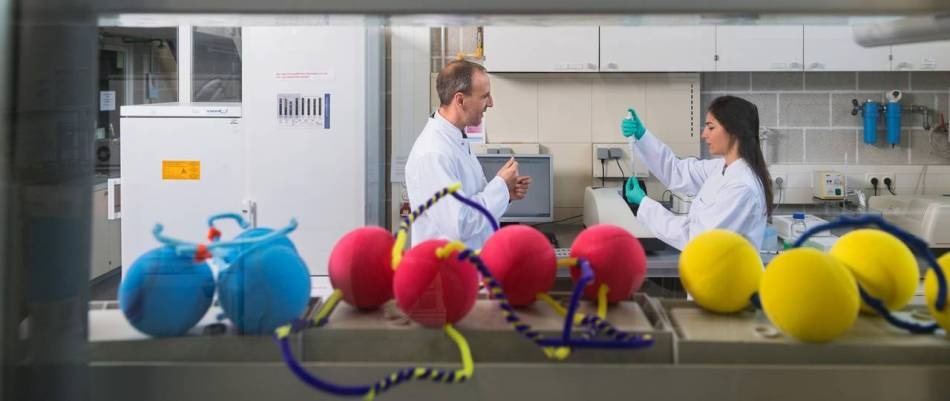Jul 1 2019
A group of researchers from the Technical University of Munich (TUM) has now brought what was once a pharmacologist’s vision much closer to reality: a drug with three active constituents that are released successively at particular times.
 Prof. Oliver Lieleg and PhD student Ceren Kimna use balls and pipe cleaners in different colors to visualize how nanoparticles can be bound together by DNA fragments. Such connections may become the basis of drugs that release their active ingredients in sequence. (Image credit: Uli Benz/TUM)
Prof. Oliver Lieleg and PhD student Ceren Kimna use balls and pipe cleaners in different colors to visualize how nanoparticles can be bound together by DNA fragments. Such connections may become the basis of drugs that release their active ingredients in sequence. (Image credit: Uli Benz/TUM)
A combination of hydrogels and artificial DNA enables nanoparticles to be released sequentially under conditions comparable to those in the human body.
It is becoming increasingly more common for patients to be treated with many different medications. It is usually essential for the patient to take them at predetermined intervals—a disadvantage that makes everyday life complicated and increases the risk of doses being forgotten or skipped.
Now, Oliver Lieleg, Professor of Biomechanics and a member of the Munich School of BioEngineering at TUM, and doctoral candidate Ceren Kimna have devised a method that could act as the foundation for medications consisting of many active ingredients that would reliably dole them out in the body in a pre-configured sequence at particular times.
For example, an ointment applied to a surgical incision could release pain medication first, followed by an anti-inflammatory drug and then a drug to reduce swelling.
Oliver Lieleg, Professor of Biomechanics, TUM
One Active Ingredient After the Other
“Ointments or creams releasing their active ingredients with a time delay are not new in themselves,” states Oliver Lieleg. However, with the existing drugs, there is no assurance that two or more active ingredients will not be released into the organism at the same time.
To verify the underlying principle of their concept, Oliver Lieleg and Ceren Kimna used nanometer-sized silver, iron oxide, and gold particles embedded in a unique gel-like substance called a hydrogel. They subsequently used a spectroscopic technique to monitor the exit of the particles from the gel.
The motion characteristics of the particles chosen by the scientists within the gel are comparable to the particles used to transport real active ingredients but are easier and less expensive to create.
Artificial DNA is a unique ingredient that controls the nanoparticles. Naturally, DNA is the significant carrier of genetic information. However, scientists are increasingly making use of another property: The capability of DNA fragments to be integrated with higher accuracy, both in terms of the strength of bonds and their types, for instance, to develop machines on a nanometer scale.
The DNA Cascade: Compress and then Release at the Right Instant
First, the silver particles were discharged. In the initial phase, the particles were attached together by DNA fragments developed by Lieleg and Kimna using exclusive software. The resultant particle clusters are so huge that they cannot move in the hydrogel. However, upon adding a saline solution, they detach from the DNA. They can now move in the gel and drift to the surface.
Because the saline solution has approximately the same salinity as the human body, we were able to simulate conditions where the active ingredients would not be released until the medication is applied.
Ceren Kimna, Doctoral Candidate, TUM
The mesh-like DNA structure that surrounds the iron oxide particles contains two kinds of DNA: The first has one end linked to the iron oxide particles. The second type is linked to the loose ends of the first kind. The saline solution does not affect these structures. The iron oxide particles can be discharged only upon dissolution of the first clusters.
This event discharges the silver nanoparticles, as well as the DNA, which removes the “connection DNA” of the second cluster without making connections itself. Therefore, the iron oxide particles can detach. This discharges DNA fragments, which in turn serve as the input to the third DNA-nanoparticle combination.
“The consistency of ointments makes them the most obvious solution for a hydrogel-based approach. However, this principle also has the potential to be used in tablets that could release several effective ingredients in the body in a specific order,” explains Prof. Lieleg.